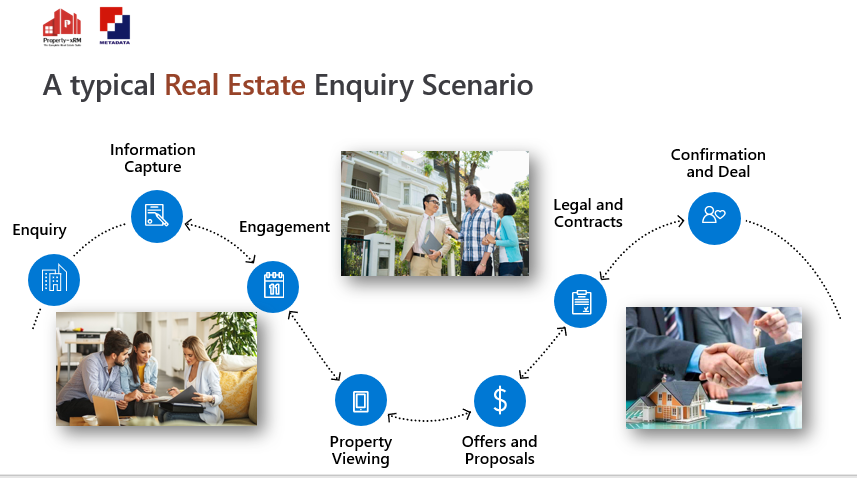
Posted By admin
 Mar 10, 2023
Mar 10, 2023 06:56:13pm
06:56:13pm A recent Microsoft survey found that 9 out of 10 workers hope to reduce their workload by getting AI to do repetitive tasks at work. In today’s world that’s digitally transforming at a rate like never before, businesses are looking to bring higher levels of efficiency at scale into daily operations. Naturally, the question will be – how does AI in real estate work?
Over the years Microsoft has proactively leveraged AI in Azure Cloud, in business applications across CRM & ERP, and on the Low-code Power Platform. This includes key automation and insights along the lines of conversational intelligence, lead scoring, predictive analysis, forecasts, the AI Builder – the list just goes on.
However, the groundbreaking headline in recent times has been the buzz around OpenAI’s generative AI – The ChatGPT. In a record advent-to-implementation plan, Microsoft partnered with OpenAI to bring GPT capabilities natively into the Microsoft Ecosystem. If you’re a Microsoft user, it certainly is exciting news! And if you’re not, it’s time to explore what this is really about.
Building on the GPT capabilities, Microsoft recently announced the Microsoft Dynamics 365 Copilot. With this update, the conversation on AI is no longer “How can I use ChatGPT?”.
It’s now a much broader question: “What all can AI do for me?”
2023 began with ground-breaking announcements and if you look at the first Quarter, it was all about CoPilot and AI. With all that’s been going around, one thing is clear – the future of technology is here. While the likes of Google and Salesforce have come up with their AI technology releases, the extent of Microsoft’s AI adoption is what makes it stand out.
Not just on the cloud, the AI capabilities extend across business applications, Office 365, and the Power Platform. Here’s a quick look at the AI timeline across Microsoft Dynamics 365 and the Power Platform. Catch a glimpse of the latest updates here.

Microsoft Dynamics 365 Copilot is the world’s first AI Copilot that is natively built into CRM and ERP.
It brings the next generation of AI capabilities and natural language processing to every line of business – ranging from sales and marketing to service and supply chain.
Business professionals can now generate ideas and content with the help of AI. They can easily transfer mundane and time-consuming tasks and let AI do the work. The tool can also obtain deep insights in addition to suggestions on the next best actions. In short, a user can describe his needs, and the AI gets it done. A little bit like a genie in a bottle, your wish is the AI’s command.
Here, we leave you with a powerful example of generative AI already incorporated in Dynamics 365 Copilot. This will give you a preview of work in the future, created by Microsoft.
Viva Sales, one of Microsoft’s earlier AI functionality, can now generate content suggestions based on customer emails. Importantly, it can populate it with data that is directly relevant to the recipient of the email. This can include pricing, promotions, or upcoming deadlines.
How this works is that first and foremost, the seller gets to choose from a set of AI-suggested reply options. Next, he/she can make minor edits to the generated content to add any level of hyper-personalization. And that’s it, the user can quickly copy out the content to email and send them out.
Today, the same task is being done manually by a seller. At first, the user sifts through tons of data to find relevant details. Then comes the manual crafting of emails one by one, incorporating personalization. And finally, the user has to double-check the information going through the CRM record.
According to Microsoft Research, everyday sellers spent 66 percent of their time at work managing emails.
The impact of AI on just one task at work is disruptive. Then what would the whole future of work created by Microsoft look like?
Property-xRM, is a vertical solution for Real Estate built on Microsoft Dynamics 365. We are always exploring ways to make work easier for Real Estate Business professionals using the power of AI.

What you see here is a standard process that companies employ – starting with a lead/enquiry, capturing information, and engaging with them via email or phone calls, or in-person meetings. Then comes a property viewing at some point, followed by the proposals. Once we get past that, we’ve got the legal procedures, contracts, and a deal. Of course, there are steps like screening that go hand-in-hand with the engagement process or you may directly want to submit a proposal in case of a property launch – all of which is possible.
The point is, at every stage of the journey, there is manual effort and data entry involved causing delays and inefficiencies. Combine this with a disparate organizational technology stack and it poses quite a challenge for companies to level up.
With the entire Microsoft ecosystem being powered by GPT and Generative AI capabilities, users can expect all the functionalities to be natively brought into Property-xRM. Be it managing the early interactions with your prospective tenants and owners, sharing proposals, scheduling site visits, or managing appointments – the possibilities with Artificial Intelligence are endless. Lead Management, Contract Management, in particular, are key areas that companies can look to automate.


